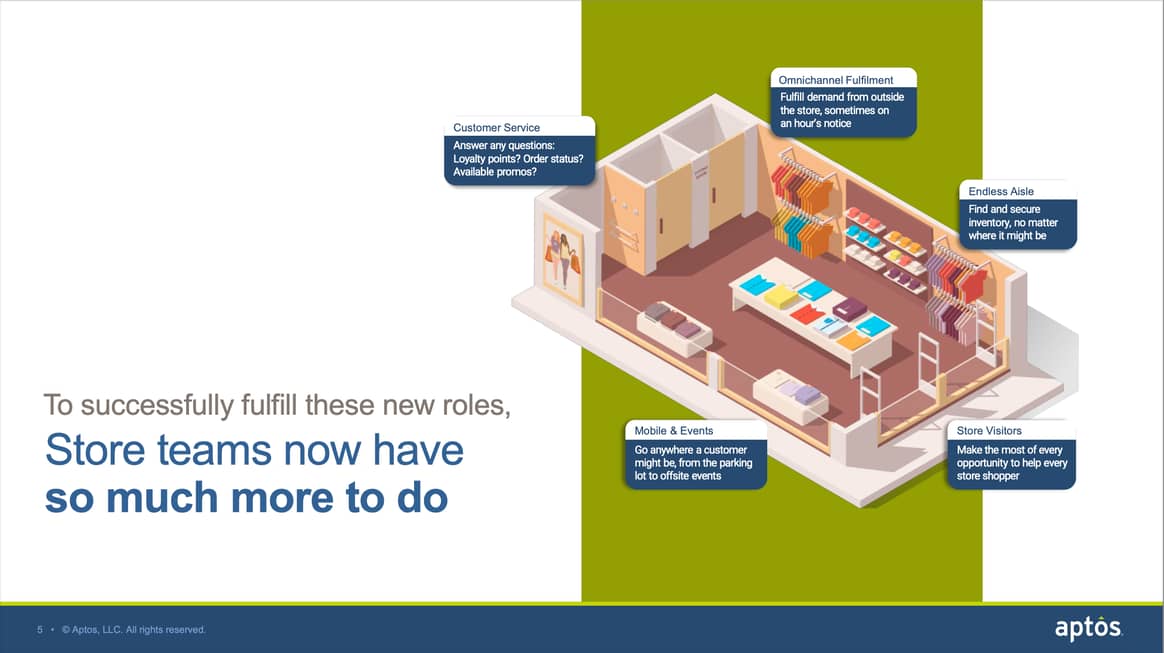As 2024 unfolds, retailers have moved from recessionary expectations to a more hopeful outlook. However, there’s a disconnect between consumer expectations and retailers’ current capabilities, and as stores evolve, they need to focus more on one-to-one connections and experiential aspects. Nikki Baird, VP of Strategy and Product at retail tech provider Aptos, walked us through some of the key takeaways from the recent Aptos Engage summit, where she presented the latest trends to a select group of retailers and brands.
Working from home or back to the office?
So far, 2024 has been something of a second half of 2023, but as the year progresses, the above question looms large for retailers. The longer consumers resist returning to the office, the more structural implications there are as retailers rethink downtown locations and instead open stores in the suburbs, often in smaller spaces, to reach consumers where they live rather than in densely populated professional urban centers.
All eyes on India
Aptos serves brands opening stores around the world, and Baird highlights a key shift that could reshape global retail trends. China, no longer seen as a major growth engine due to a weak economy and low spending (whether that’s due to declining interest in Western brands or genuine economic hardships, it’s still unclear), has been replaced by a focus on India. The number of stores it can open or the number of consumers it can reach in this new target area won’t be clear until early 2025, when full annual financial results are released. And while retailers can look forward to a more stable supply chain, with a caveat about the Red Sea, post-pandemic disruptions have already led to solutions, with many companies moving production to Southeast Asia and out of China.
Retail trends that could backfire on brands
Wellness, which has been a trend since the pandemic, encompassing mental, physical, emotional, proactive and preventative health, is at the forefront of consumers’ minds to the point that retailers, while not medical experts and traditionally never had to equip themselves for this role, are expected to participate in delivering this well-being. Another pandemic remnant, the anti-consumerist “less is more” trend, is also big. Customers are inclined to consume less and they expect retailers to help them do so, a concept that runs somewhat counter to retail.
So while a focus on personalization can increase loyalty and sales in the short term, it can backfire if it drives the consumer into a space of unconscious consumption. Retailers who make it too easy to buy risk damaging their reputation with consumers.
Embrace the chaos
Retailers who are seen as inflating prices while their CEOs receive huge bonuses and stock gains are no longer tolerated by consumers, and Baird says that goes some way to explaining the current high in-store theft rates. Consumers feel justified in wanting their fair share. Manifesting optimism, the 2023 trend of believing that things will get better despite the dire state of the world, is gone. In its place is the current movement to embrace chaos in a 12-step-like manner, realizing that we can’t move forward until we acknowledge our current circumstances. Beyond the curated-to-death perfection of Instagram, consumers are also rejecting traditional life stages because they can’t afford them: graduating from high school, college, getting married, buying a house or car, having children—all milestones that retailers used to use as methods to target customers—are no longer relevant or representative of a demographic group. Behavioral segmentation is the new reality.

Evolution of the modern store
The role of the store in customer acquisition is more important than ever and a customer acquired in-store is infinitely more profitable and loyal to a brand than a customer acquired online. Retailers are responding by investing in mobile technology, moving staff out from behind the till, onto the sales floor and providing them with full product knowledge in-store with stock held elsewhere. Retailers that previously would not have been categorised as event-driven retailers are now interested in pop-up events to engage customers. Gen Z and Alpha have been huge drivers of the physical store revival and problem solving is important to them. Customer service now almost needs to act as a call centre, directing these consumers into the store for collection or returns so that if an item is not satisfactory, brands have the opportunity to turn the experience into a positive one.
The mobile shopping experience
Retailers are working hard to bring customers in, but one interesting development Baird notes, and an evolution of the pandemic phenomenon of curbside pickup, is the ability for retailers to serve consumers outside of the store, even while waiting in line. Sneaker retailers that schedule product drops that typically result in lines around the block are taking advantage of this technology. Taking a mobile device into a high-traffic area, even into the parking lot, to help customers get on their way without having to wait in line is akin to bringing retail to where the customers are. On a larger scale, Boot Barn’s presence at rodeos and New Balance’s pop-up for the New York City Marathon are successful examples of staging sales events that account for a huge amount of volume with engaged consumers, then packing up the operation and removing all traces of it.
This article originally appeared on FashionUnited.com. Translation by AI, editing by Caitlyn Terra.
Source: fashionunited.nl


